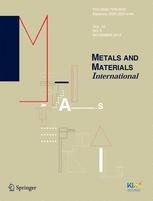 Chang-Suk Han, a member of the engineering faculty at Hoseo University in South Korea, has had ten articles retracted at once because of duplicated data.
Chang-Suk Han, a member of the engineering faculty at Hoseo University in South Korea, has had ten articles retracted at once because of duplicated data.
Here are the ten studies from Metals and Materials International:
- Precipitation Behavior of B2-ordered Aluminide (2006)
- Dislocation-Particle Interaction in Precipitation Strengthened Ll2-ordered Ni3Al (2007)
- Microstructure of Carbide Precipitates in L12-Ni3Al and L10-TiAl (2008)
- Microstructure and Strength of B2-ordered (Ni,Co)Al (2008)
- The Behavior of α-Cr Precipitation on the High Temperature Deformation of B2-Ordered NiAl (2009)
- Microstructure of Co Precipitation Strengthened B2-Ordered NiAl (2010)
- A Study on the Microstructure of Precipitation Strengthened B2-ordered NiAl (2011)
- Precipitation Behavior of Al-Ti-Ag Alloy System (2012)
- Microstructures and Morphologies of B2-Ordered NiAl(Co) and FeAl(Co) (2013)
- Microstructure and Strengthening Mechanism of Ni3Al Intermetallic Compound (2013)
And here’s the notice:
The editorial board of Metals and Materials International has decided to retract articles listed above. The retraction is due to the fact that some data have been used as in previously published papers without indication that the data had been published previously.
It’s not clear whether this means duplication or plagiarism, although we’re guessing the former. We’ve asked Han and the publisher, Springer, for more details, and will update with anything we learn.
Most of the papers are cited once or not at all, according to Thomson Scientific’s Web of Knowledge. One has been cited nine times.
Hat tip: Rolf Degen
Ghastly, absolutely ghastly. The Springer cookie is crumbling. And even worse because the notice has absolutely no specifics, i.e., almost zero transparency. For example, one would think that the readership and public should be informed of the exact previous papers that contained the “original” figures. Also, the exact figures that were duplicated, page numbers, DOIs, etc. This is a nightmare notice because it leaves so many gaps in our information. Does Springer now expect the readership to go trawl through data-bases or Google to try and identify these “originals”? Of course, as for all these cases, the authors were wrong. But this also indicates that peer review and editorial responsibility failed on a massive scale: at least 10 times. This now calls into question the robustness of the peer review system and how many other papers in this journal made it through.
Indeed. Also if ten papers have been retracted for duplicated data surely there is one or more that contain(s) the original data? If so what and where is it? It appears the journal has gone to a lot of work to trawl through the papers to locate duplicated data – so why not make it available? The hard work has been done so why ask the rest of us to repeat it?